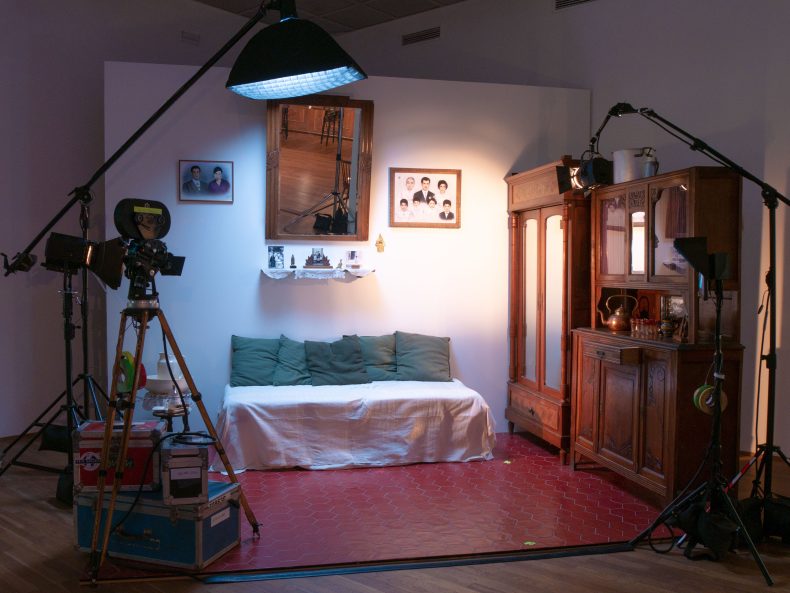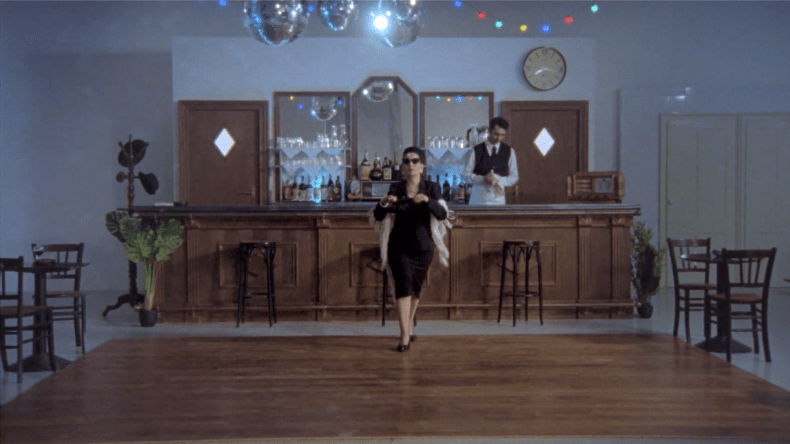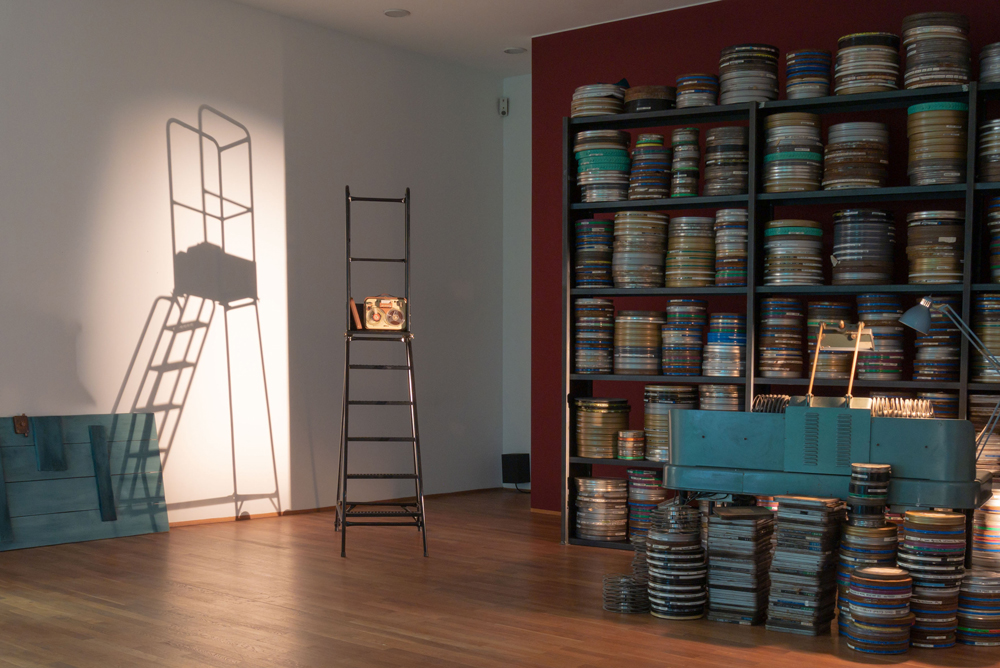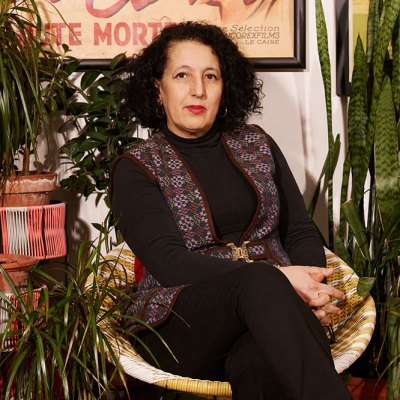Few films are more conceptually daring than Ettore Scola’s Le Bal (1983). An attempt to chart changes in French society from the 1930s to the ’80s using only dance, costume and body language, the movie is set in a single dancehall. In place of dialogue – the characters utter no words whatsoever – there are physical interactions, facial expressions, pas de deux. The overall impression we are left with, despite the changes in music, fashion and lighting, is one of unchanging human behaviour.
Zineb Sedira’s ‘Dreams Have No Titles’ turns this conceit on its head. An ambitious exhibition spread over two floors and several rooms of Whitechapel Gallery, this series of installations begins with a room-size simulacrum of Scola’s dancehall, complete with art deco bar, neatly arranged tables with half-full ashtrays and a small stage with unmanned musical instruments. At first, it seems to evoke the contradictions to be found in Le Bal: is it pregnant with potential, or does the ghostly lack of patrons speak to a lack of communal energy? Is the vigorous arrangement of Jacob Gade’s tango ‘Jalousie’ – which visitors hear as they enter – an invitation to dance, or does its insistent looping suggest a people trapped in a groove?
Le Bal (Dreams Have No Titles) (2022), Zineb Sedira. Photo: Thierry Bal; courtesy Venice Biennale

This particular installation turns out to be more hopeful than first appearances suggest. In place of stasis, there is personal growth: the empty dancehall is a tabula rasa, scene-setting for Sedira’s journey of self-actualisation. Given that this journey is told largely through a series of recreated film sets, Le Bal seems an apt starting point: its status as a French-Italian-Algerian production reflects the artist’s own identity as a Paris-born woman of Algerian descent who has lived in London for a long time. This theme of displacement is reinforced by the installations that follow: an imitation set of a domestic scene from The Battle of Algiers (1966) and some architectural designs (and a wooden coffin) from The Stranger (1967), an adaptation of Camus’s novel. Both these films are set in a colonised Algeria and filmed in the country after it gained its independence; like Le Bal, both are directed by an Italian – Gillo Pontecorvo and Luchino Visconti respectively.
The Battle of Algiers (Dreams Have No Titles) (2022), Zineb Sedira. Photo: Mathieu Carmona; courtesy Hamburger Bahnhof; © Zineb Sedira/DACS, London 2024

There is an unresolved tension here, however, between the exhibition’s professed aims: on the one hand, an homage to collaborative, political, resistance-driven film-making, typified by The Battle of Algiers (1966); on the other, a personally specific memorialisation of the cultural contours of one woman’s life. These two strands are seemingly reconciled by an installation towards the end of the exhibition, a replica of Sedira’s own living room in her Brixton home. A TV screen carries a 40-minute discussion between the artist Sonia Boyce and the curator Gilane Tawadros (now director of Whitechapel Gallery) about the difficulties of making and exhibiting Black art. We are invited to watch it from a comfy 1960s-style settee, glasses of wine and two dense anti-colonial conference booklets placed on a coffee table. Visitors could spend an hour in this room alone, hacking through the thickets of theory in these spiral-bound tomes, watching the colloquy on the screen and walking around, perusing the record sleeves, posters and artefacts of a life lived fully.
F for Fake (Dreams Have No Titles) (2022), Zineb Sedira. Photo: Mathieu Carmona; courtesy Hamburger Bahnhof; © Zineb Sedira/DACS, London 2024

But the set dressing here is so specific – this is no longer a film set, but the recreation of a real living space – that any points about the role of political cinema are subsumed into an autobiographical narrative. Sedira is aware of the shaky relationship of film to reality and authenticity: the fourth film she evokes, Orson Welles’s F for Fake (1973), is an exploration of this very theme. It is represented here by a large film-editing deck – perhaps a playful nod to Sedira’s careful curation of her own cinephilic touchstones, or a reminder that the value of film is not so much objective as personal. But though this installation infuses the show with notions of instability and unreliability, one wonders what exactly is being destabilised. Sedira never makes it clear why these films resonate with her, beyond their hybrid provenances. Their settings in (or references to) colonial Algeria aside, Le Bal, The Battle of Algiers and The Stranger have little in common.
Perhaps the real story here is an unconscious one. If the exhibition plays out as a gradual construction of self – the emptiness of the opening gallery giving way to more finely detailed scenes – it suggests how revolutionary ardour and existential inquisitiveness can soften over time into nostalgia.
Still from Dreams Have No Titles (2022), directed by Zineb Sedira; courtesy Zineb Sedira

After the comforts of the recreated living room, we come to a mini-cinema, where Sedira’s 23-minute film Dreams Have No Titles (2022) is being projected. Touching on all the mentioned movies and Sedira’s own life, the film ends with the artist dancing against an empty yellow background while Charles Wright’s ‘Express Yourself’ plays in the background. The underlying message appears to be not only that self-expression is full of mediations and fabrications, but that these are part of the fun. Seen in this way, the dance underlines the chief strength of this show: its exuberant use of space. Intermittently, in the art deco barroom, two tango dancers take to the floor, getting the show off to a celebratory start for anyone who happens to catch their moves. Meanwhile, the sheer sprawl of the installations feels like an invitation to scale the scaffolding of Sedira’s cultural memory – a pleasure not lost on the crowds who made the French pavilion, which first hosted a version of this exhibition, such a hit at the Venice Biennale in 2022. ‘Dreams Have No Titles’ may be too diffuse to bear the weight of its themes, but Sedira’s joie de vivre makes a convincing case for prizing the playful over the pensive.
‘Zineb Sedira: Dreams Have No Titles’ is at the Whitechapel Gallery in London until 12 May.



